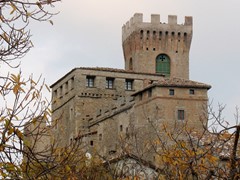Municipality of Pavullo.
The Castle of Montecuccolo
From Pavullo, heading for approximately 4km in the direction of Lama Mocogno, we arrive at the village of Montecuccolo. This was the centre of the Montecuccoli family’s fiefdom and it is here that we can still find the most important reminders of them, starting from the castle itself where their centuries-long history as feudatories and lords of the Frignano region began.
At the top of the steep ramp after crossing through the entrance portal, we find ourselves in the fortress’s large internal courtyard, dominated by the tower which was probably built somewhere round the XII century, when the Montecuccoli Ghibellines, battling the Guelph families for dominion of Frignano, were consolidating their power. The tower was defended by a first circle of walls, while an underground cistern at the foot guaranteed its water supply.
The arch we see today to enter the small courtyard was opened later on, as explained in writing on the arch’s keystone: GALEOTUS MC alias Montecuccoli 1549. In the north-western part, along the steepest part of the mountain, the Montecuccoli gradually built their residence in successive phases between the XII and the XVI centuries. In reality this was a complex of buildings from different ages superimposed on one another. The oldest nucleus is the so-called “old palace”, which collapsed during the XIX century and was never rebuilt except for the outside wall. To this was added the “new palace”, consisting of two wings, one towards the north, the other towards the south, encircled by the second wall.
After constructing the piazza tower at the southern end, the whole of the upper village was enclosed within the third wall. The various parts that make up the fortress’s complex structure were erected in successive phases according to a precise scheme along the steep mountainside between the XII and XVI centuries, in parallel with the clinching of the Montecuccoli’s power in Frignano
The XVI century also saw the construction of the small round tower with its stone spiral staircase to facilitate access to the various storeys, while much work was done to transform the austere fortress into a stylish palace with its rooms frescoed according to contemporary taste.
The fortress was devastated by French soldiers in 1799 and left to its own devices for decades. As a result, nowadays nothing remains of the furniture, the pictures, or even the original structure, which was heavily altered at the end of the XIX century when it was purchased by Monsignor Gaetano Bonvicini to turn into rooms to let.
The palace is entered from the door that gives onto the larger courtyard. After the small entrance hall access to the three upstairs floors is via a magnificent spiral staircase whose steps are single blocks of stone. The walls are perforated by loopholes to keep an eye on various points of the fortress.
On the piano nobile lived the feudatory with his family. Of note in one of the rooms is the imposing stone fireplace whose architrave is richly decorated with the Este symbol of a Diamond in the centre, with the Montecuccoli crest to the left of this, and a spiral decoration portraying a stylized sun. On the left, the mysterious initials RA with the date 1488.
On the same floor, inside the piazza tower, is the General’s room, where, according to legend, General Raimondo Montecuccoli saw the light. This memory, handed down to our own days, saved the room from destruction, and today we can admire it as it was in 1545, decorated according to prevailing Renaissance taste.
The decorations that run around the top of the walls are interspersed with numerous Latin mottos and Montecuccoli family crests, often accompanied by those of the wives belonging to the noble families, the Molza from Modena, the Pico from Mirandola, the Pio from Carpi, and the Landi from Ferrara.
Other characteristic elements of the room are the four round loopholes a metre above floor level which betray the tower’s original military function.
It is unknown where the kitchen was exactly, however contemporary documents refer to a housewife with three assistants.
Upstairs is Frignano’s “Ferruccio Minghelli” Natural History Museum, with displays of material on Earth Sciences.
On its shelves are samples of rocks, fossils and minerals which constitute a priceless lithological and mineralogical testimony of the Frignano region. Also the paleontological section contains local finds, with rooms devoted to flora and fauna. Of particular scientific interest is the precious herbarium which preserves 6,000 samples from the collection of the botanists Mori, Lunardi and Riva.
From the museum’s first room we can go outside onto the battlements, protected by merlons, to admire an arresting panorama of the whole of the Frignano.
The castle is also home to two interesting art collections, one of the painter Gino Covili, the other of the sculptor, Raffaele Biolchini, both eminent local artists.
We now descend to the lowest part of the courtyard, at the main entrance to the upper village. On the left is the door to the guard room, on the right a narrow splayed loophole to check on the outside access ramp. Again on the right, a narrow passageway leads down to a small prison, in the basement of the piazza tower.
The plastered walls are covered in graffiti and writings left by the prisoners who served out their sentence here.
The massive building backing onto the south-eastern wall was the Podesteria, a set of constructions including the Podestà’s palace, the law court, the torture room, the prisons, and even the Podestà’s residence with a stable and a small building for drying chestnuts.
All these buildings date back to the 1400s when the Duke established the Podesteria.
By now completely restored, the former Podestà palace is home to a modern hostel.
